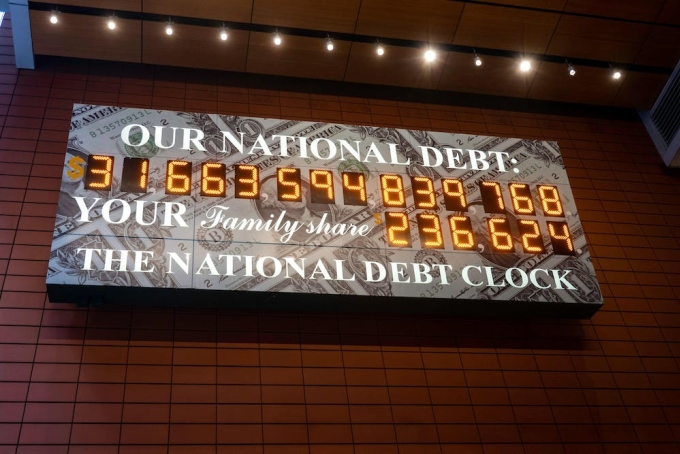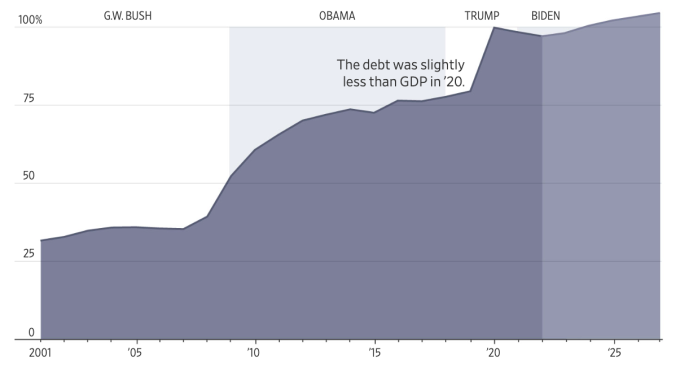American politics is trying to finalize a plan to increase the public debt ceiling, but even if successful, it still cannot dispel risks for this country and the world .
On a Manhattan wall, not far from Times Square, the U.S. debt clock has grown from $3 trillion when it was unveiled in 1989 to more than $31 trillion. After years of constant ticking without any apparent recession, and having been moved from a busy street corner to a quiet alley, the clock has gone largely unnoticed.
But now the relentless rise in debt that the clock reflects is becoming a major concern. The numbers are now soaring above the US debt ceiling, and that is a risk not just to the US but to the global economy .
The debt ceiling is the maximum amount of money Congress allows the U.S. government to borrow to meet basic needs, from health care to military salaries. The current debt ceiling is $31.4 trillion, or 117% of U.S. GDP. Treasury Secretary Janet Yellen warned on May 1 that the government would run out of cash reserves and other ways to raise funds as soon as June 1.
At that point, the US would face either a national debt default or massive cuts in government spending, either of which would wreak havoc on global markets, according to The Economist .
A default would erode confidence in the world's most important financial system, while large-scale budget cuts could trigger a deep recession in the world's largest economy.
Even if Congress manages to raise the debt ceiling before anything serious happens, the move is a wake-up call about America's deteriorating and difficult-to-recover fiscal health.

The US debt clock in Manhattan, New York in November 2022. Photo: Patti McConville
The debt ceiling is a US political invention that makes no fundamental economic sense, and no other country has tied its own hands so brutally, says the Economist . And because it is a “political invention,” it also needs a “political solution.”
Investors are starting to worry about whether Democrats and Republicans can work together to resolve the issue. Yields on Treasury bonds maturing in early June rose a full percentage point after Yellen’s warning, a sign that fewer people want to hold U.S. government bonds.
A bill proposed by House Speaker Kevin McCarthy would raise the debt ceiling in 2024, cut trillions of dollars in spending over the next decade and scrap plans to combat climate change. The Republican-controlled House passed the bill on April 27, but because it was not initiated by Democrats, it will not pass the Senate.
But the odds are that American politicians will somehow find a way to break the impasse, as they have done in the past. President Joe Biden has invited leaders from both parties to the White House on May 9, where they will negotiate a bill to raise the debt ceiling that satisfies both sides.
If and when that happens, the debt clock will stop ticking. But the fact remains that America’s finances are increasingly precarious. In other words, the key measure of financial vulnerability is not how much debt America has, but how large its budget deficit is.
Over the past half-century, the U.S. federal budget deficit has averaged about 3.5 percent of GDP a year. Some politicians see this as evidence of profligacy. In its most recent update in February, the Congressional Budget Office (CBO) forecasts the deficit will average 6.1 percent over the next decade.
According to the Economist , this is still a modest forecast because the CBO does not take into account recessions, but rather normal economic conditions. Even without spending as big as during Covid, a recession still leads to higher deficits as tax revenues fall while social security spending like unemployment insurance increases.
Additionally, the CBO initially estimated that the Biden administration would spend about $400 billion over the next decade on subsidies for things like electric vehicles and renewable energy. But because many of the subsidies come in the form of unlimited tax credits, Goldman Sachs says the actual cost would be $1.2 trillion.
Moreover, the CBO only makes projections based on current law. As the political landscape changes, so do laws. In 2017, Donald Trump cut taxes in bulk, and they expire in 2025. When making projections, the CBO should have assumed that they would expire as scheduled. But few politicians want to raise taxes. Biden also wants to cancel student debt, which would add to the deficit.
In short, taking into account only the underlying variables, including higher spending on industrial policy and continued tax cuts, the budget deficit will average 7% over the next decade, reaching close to 8% in the early 2030s, the Economist .
Year after year, increased borrowing will add to the national debt. The CBO projects that federal debt will double to nearly 250 percent of GDP by mid-century. By then, New York’s debt clock, which currently ticks to 14 digits, will need to add a 15th as the national debt passes $100 trillion.
There is no clear threshold for debt or deficit beyond which there would be immediate problems. Instead, the expansion of either indicator has a corrosive effect on the economy. As the debt pile grows, and interest rates rise, the burden of paying it back becomes more onerous.
At the start of 2022, the CBO projected the average interest rate on three-month US loans to be 2% over the next three years, but that has now been revised down to 3.3%. Interest rates could fall in the future or remain high for a long time. In today's high-interest-rate world, large deficits could spell trouble.
To raise money to borrow, the government must attract a larger share of private savings. This leaves less capital for business spending, reducing the ability to invest. With less new capital injected, people’s incomes and productivity grow more slowly. The result is an economy that is both poorer and more volatile than if the budget deficit were kept under control.

US public debt to GDP ratio (%) through presidential terms. Graphics: WSJ
The White House estimates that the funding for Social Security and Medicare will be exhausted by the early 2030s. At that point, the United States will face a fundamental choice between cutting benefits and raising taxes. The same will happen to every other aspect of the federal budget.
“Ordinary Americans have spent the 21st century with presidents saying we don’t have problems. So why bother with difficult reforms now?” said Douglas Holtz-Eakin, who headed the CBO under George W. Bush. He predicted a generation of voters who couldn’t get what they wanted because money had been spent in the past.
Obama's CBO chief, Doug Elmendorf, said Republicans have learned that cutting benefits is harmful, while Democrats know to avoid raising taxes. Both approaches cost the federal budget a lot. "So it's increasingly difficult for either party to develop a sustainable fiscal policy plan, let alone agree on a set of policies," he said.
Phien An ( according to The Economist )
Source link

































































































Comment (0)